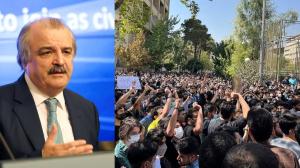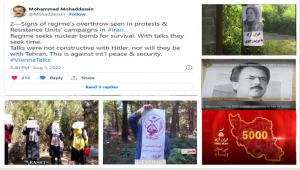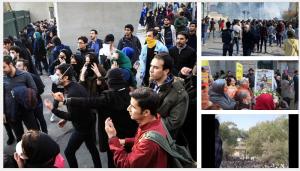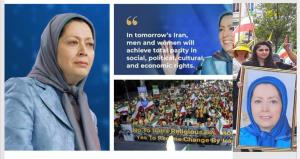Human Rights - Elections Info originally published at Human Rights - Elections Info


Protests in Iran have continued for six weeks, and the state of Iran’s society is so explosive. we sat down with Mr. M.Mohandessin to address the many questions Iran observers may have as they try to explain the cause of the recent upheaval in Iran.

In this interview, the Foreign Affairs Committee Chairman responds to a number of these questions, including whether or not the uprising is organized, has leadership, and staying power. The role of women & what are the prospects in the weeks and months ahead?

To the first question, Mr. Mohaddessin said, protests were sparked by the tragic death of Mahsa Amini which was not planned. In that sense, one could say the protest started spontaneously. But, this tragic incident ignited a society that was ready to explode.

Mr. Mohaddessin. Let me clarify one issue. The primary question is not the leadership but the intensity of the protests& to what extent it is organized. Of course, being organized in a totalitarian state is different from what we see in a democratic country.

To follow up on that question, how did women attain such a leading role in these uprisings? The fact that the President-elect of the main democratic opposition Maryam Rajavi has inspired generations of women to learn about their rights, & empower themselves.
Maryam Rajavi has inspired generations of women to learn about their rights, empower themselves, and persevere in their struggles at all costs.
— NCRI
PARIS, FRANCE, October 26, 2022 /EINPresswire.com/ — “No citizen shall enjoy any privileges or be subject to any deprivations for the reason of belief or non-belief in a particular religion or denomination.”
Protests in Iran have continued for six weeks, catching observers by surprise because they did not envision the state of Iran’s society to be so explosive.
We sat down with Mr. Mohaddessin to address the many questions Iran observers may have as they try to explain the cause of the recent upheaval in Iran, which is universally agreed to be the most serious threat to the 43-year existence of the theocracy that has ruled by an iron fist.
In this interview, the Foreign Affairs Committee Chairman responds to a number of these questions, including whether or not the uprising is organized, has leadership, and staying power. And what accounts for the prominent role women are playing, and what are the prospects in the weeks and months ahead?
Mr. Mohaddessin is the author of “Islamic Fundamentalism, the New Global Threat,” originally published in 1993, and “Enemies of Ayatollah,” published in 2004.
The full text of the interview:
Q: Protests in Iran have continued for six weeks. However, some believe that these protests are spontaneous, and unless there is some kind of organization, they will not survive the regime’s repression. What do you say to that?
Obviously, protests were sparked by the tragic death of Mahsa Amini, a 22-year-old Kurdish woman, while in custody, which was not planned. In that sense, one could say the protest started spontaneously. But, this tragic incident ignited a society that was ready to explode.
What we are seeing is a protest movement that has for 39 days continued in all major urban centers and over 198 cities in all of Iran’s provinces in the face of the most brutal crackdown by a ruthless dictatorial regime. There is no sign of the protesters backing down or the protests abating. This fact in and of itself suggests the existence of structure and organization. Those who see the protests as a spontaneous movement, ignore the fact that absent some kind of organization, protests with a unified demand to end the regime could not survive the regime’s brutal crackdown.
In addition, the regime’s security apparatus, including the IRGC, is organized to prevent such protests from taking place. In particular, following the uprising in 2009, the IRGC was reorganized with the specific mission of preventing any protests demanding regime change. The MOIS also plays a key role in this respect.
Therefore, ignoring the context of these protests and suggesting that they are spontaneous is a simplistic analysis of the situation. A false narrative could be due to a lack of understanding of the situation in Iran. It would be a misnomer to disconnect such persistence, such resilience, and such sharp political messaging in the protesters’ remarkably targeted slogans from its roots and the context in which it is taking place.
Q: Can you provide any evidence that these protests are organized? You argued that they are not leaderless, but what are the signs that they are organized?
First, let me clarify one issue. The primary question is not the leadership but the intensity of the protests and to what extent it is organized. Of course, being structured and organized in a totalitarian state is different from what we see in a democratic country. I just briefly highlight a few facts.
Today’s events in Iran must be considered and analyzed in the correct context. A similar incident, if it happens in a democratic country, might lead to spontaneous protests and demands for certain reforms in the police and security apparatus or prison organization but will not lead to demand for regime change, which is the case in Iran now.
The objective conditions in Iran provide the real context in which these protests are taking place. Over forty years of political and social repression and economic corruption, and mismanagement have led to this moment. It is rooted in forty years of organized resistance and the regime’s crimes as reflected in 120,000 political executions and the 1988 massacre of 30,000 political prisoners, mostly because they refused to renounce their affiliation with the People’s Mojahedin Organization of Iran (PMOI / MEK). These are part of Iranian history and embedded in the conscience of the Iranian nation that cannot be erased.
In addition, over the past few years, MEK Resistance Units have carried out extensive activities across the country by raising awareness through writing wall graffiti, putting up posters, and above all, targeting and torching all regime symbols, including pictures of Khamenei, Qassem Soleimani, the notorious Quds Force commander. These activities have instilled in Iran’s youth and women a culture of defiance, which is manifested in this uprising in the bold fighting mood of the younger generation and the targeting of all symbols of the regime.
Furthermore, these Resistance Units are also playing a vital role in initiating or managing the continuation of the protests as well as guiding its direction by focusing on the core demand of the Iranian people for regime change.
Q: Women are playing a leading role, and some are describing it as a feminist revolution, focusing on demands for women’s rights such as freedom of choosing their attire. What are their demands?
The regime’s inhuman behavior towards women, through policies of gender apartheid and compulsory veiling, which targets half of the population directly, was a major factor in sparking the protests following the tragic killing of Mahsa Amini. Women have also been instrumental in galvanizing the public to express outrage at the regime and participate in the protests.
The demand of the Iranian people including women, however, goes further than this one issue, and their prime demand is to get rid of the religious dictatorial regime in its entirety. Because the Iranian women know well that their desire for gender equality will not be attained so long as this regime is in power. Therefore, restricting their demand to one or two of their social rights, which will never materialize under this regime, is not what they are seeking, and such an impression is a misreading of their brave struggle and the price they are paying by their defiance against the repressive forces of the regime.
Q: To follow up on that question, how did they attain such a leading role in the uprising? Is it a coincidence? Is it due to the initial spark for this new wave of protests?
The active presence and the leading role of women in the uprising is not a spontaneous phenomenon. They are a major force for change for good reason. Misogyny is ingrained in the ruling religious tyranny. Since the first day that the mullahs usurped power after Iran’s anti-monarchical revolution in 1979, they made it clear that the suppression of women under the guise of religion is the bedrock of all their policies and a strategic priority. Thus, Iranian women’s struggle for equality has been ongoing for decades and remains key to obtaining freedom and democracy for the broader population.
Since the 1980s, the regime has killed thousands of brave women and tortured tens of thousands more in jails. Today’s women and young girls standing up to the regime’s monstrous repressive forces have inherited the same pedigree of courage and resilience.
The fact that the President-elect of the main democratic opposition coalition, the National Council of Resistance of Iran (NCRI) is a woman, Maryam Rajavi, has inspired generations of women to learn about their rights, empower themselves, and persevere in their struggle at all costs. Indeed, in a speech before 25,000 people at London’s Earl Court on June 21, 1996, she said, “The misogynous mullahs are determined to destroy Iranian women’s rights and freedoms and trample their dignity. In this way, they want to solidify the pillars of their authoritarian rule. To the misogynistic mullahs, I must say that you are utterly wrong; you will never attain your wishes. You have used all possible forms of humiliation, oppression, repression, torture, and murder against Iranian women. But be sure you will receive the fatal blow from those you never count. Of course, your reactionary nature does not allow you to consider them. But be sure that your oppressive rule will be swept away by Iran’s conscious and free women.”
Q: Does the NCRI have a specific plan for the rights and freedom of women?
The (NCRI) does have a plan for women, but as a member of the PMOI and a Muslim, let me point out that women’s rights and gender equality are not just political programs for us; they are also ideological issues. From the point of view of Islam, the way we look at it, and Mrs. Rajavi has said many times, compulsory religion, compulsory hijab, and any religious compulsion are against the foundations of Islam and the clear text of the Qur’an and the teachings of the Prophet.
Q: What is the strategy of the protests? Is there any strategy? Some argue that the protests do not have a clear direction. No leadership; what is your view on that?
For years three different strategies have been identified to bring change to Iran.
One strategy relied on elements or groupings within the regime itself, i.e., the so-called moderates. Years of so-called “reformist” governments in this regime, and their loyalty to Khamenei and the system at critical junctures when it is threatened, have made the people fed up with this ploy. This has already proved to be a failure, with people chanting “reformists, hardliners, the game is now over,” back in 2017 until today when the protests have moved past these ploys with everyone admitting that only regime downfall is the nation’s demand.
Another strategy relies on what is known as civil disobedience. This strategy expects that the regime will gradually disintegrate from within in the face of passive disobedience. Its proponents hopelessly count on the regime’s repressive force, IRGC, to change sides and provide a counterforce to the regime. Developments in the past month laid bare the futility of this approach.
In our view, experience has shown that this regime will not change its behavior. It will continue brute repression to its last breath. Face with such a regime, civil obedience, as a central or primary tactic, will never succeed and cannot be a viable strategy. Similarly, expecting the IRGC to change sides is simply naive.
We have always been of the view that in light of the regime’s nature and reliance on force as the pillar of its survival, the right strategy is to be more structured and organized to confront the brute force of the regime, as is the inalienable right of the people who it rules without their consent. An aspect of this strategy is to tear down the wall of repression to overcome the fear that the regime has imposed on society and for more people to join the resistance.
Based on this strategy, we began the painstaking task of forming Resistance Units some years ago, in 2014. The MEK believed that having an organized network inside Iran is indispensable to overthrowing the regime. In 2021, some 1000 Resistance Units sent video messages to the annual summit of the resistance to underscore their determination to topple the regime. In 2022, 5000 members of Resistance Units made the same pledge through video clips.
What is happening in the streets of Iran’s cities serves as a vindication of this strategy. The culture of defiance, which is manifested in the targeting and torching of all symbols of the regime and confronting the repressive forces of the regime with bear hands or any means, is the positive response of the protesters to this strategy.
The persistence of anti-regime demonstrations throughout the country and the passion and fearless enthusiasm of the younger generations to confront the repressive forces further represent the broader society’s unified strategy of overthrowing the regime.
Q: You talked about the NCRI platform. Can you elaborate on this platform and program?
The NCRI’s platform advocates a democratic republic based on popular vote, gender equality, separation of religion and state, equality of all ethnicities, a free market economy, and a stated policy of no nuclear proliferation.
Once the clerical regime is toppled, according to the NCRI’s platform, a provisional government will be formed for the transitional period, which must not exceed six months. Its main responsibility is to organize a free and fair election for a National Legislative and Constituent Assembly within six months and transfer power to the newly elected representatives of the people of Iran. The Constitute Assembly will determine the future form of government in Iran.
The NCRI pledges to uphold the Universal Declaration of Human Rights and all international covenants on human rights, including “freedom of association, freedom of thought and expression, media, political parties, trade unions, councils, religions and denominations, freedom of profession, and prevention of any violation of individual and social rights and freedoms.”
The NCRI recognizes “the right of women to vote and stand as candidates in all elections, and the right to vote in all referenda,” “the right to employment and free selection of profession, and the right to hold any public office, including the presidency or judgeship,” “the right to freely choose to clothe,” and “the right to use, without discrimination, all instructional, educational, athletic, and artistic resources; the right to participate in all athletic competitions and artistic activities.”
The NCRI believes in the separation of religion and state. According to its ratifications, “all forms of discrimination against the followers of various religions and denominations in the enjoyment of their individual and social rights are prohibited. No citizen shall enjoy any privileges or be subject to any deprivations with respect to the nomination for election, suffrage, employment, education, becoming a judge, or any other individual or social rights for the reason of belief or non-belief in a particular religion or denomination.”
The NCRI recognizes the rights of all ethnic and national minorities. It has adopted a plan for the autonomy of Iranian Kurdistan, specifying “the administration of all affairs of the autonomous region of Kurdistan,” except for those related to foreign policy, national defense, national security, foreign trade, and customs, “fall within the authority of the autonomous institutions.”
Article 7 of Mrs. Rajavi’s 10-point plan states, “Autonomy for and removal of double injustices against Iranian nationalities and ethnicities consistent with the NCRI’s plan for the autonomy of Iranian Kurdistan. The annual declaration of the NCRI, which was approved by its 460 members and published in October, again underscored Mrs. Rajavi’s 10-pint-plan for the future of Iran.
Shahin Gobadi
NCRI
+33 6 61 65 32 31
email us here
Speech by Maryam Rajavi At the Iranian Resistance’s Grand Gathering “ Free Iran- The Alternative” Paris, June 30, 2018
![]()
Article originally published on www.einpresswire.com as Interview with Mohammad Mohaddessin, Chair of NCRI’s Foreign Affairs Committee
originally published at HUMAN RIGHTS - USA DAILY NEWS 24
Human Rights - Elections Info originally published at Human Rights - Elections Info
 ,
,



